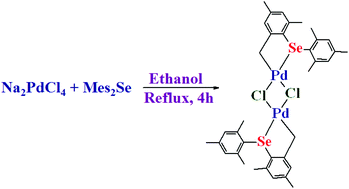Cyclopalladation of dimesityl selenide: synthesis, reactivity, structural characterization, isolation of an intermediate complex with C–H⋯Pd intra-molecular interaction and computational studies†
Abstract
The reaction of

* Corresponding authors
a Chemistry Division, Bhabha Atomic Research Centre, Mumbai 400085, India
b
Department of Chemistry, Indian Institute of Technology Bombay, Powai, Mumbai 400076, India
E-mail:
jainvk@barc.gov.in
Fax: +91 22 2550 5151
Tel: +91-22-2559 5095
The reaction of

 Please wait while we load your content...
Something went wrong. Try again?
Please wait while we load your content...
Something went wrong. Try again?
S. Kolay, A. Wadawale, D. Das, H. K. Kisan, R. B. Sunoj and V. K. Jain, Dalton Trans., 2013, 42, 10828 DOI: 10.1039/C3DT50935D
To request permission to reproduce material from this article, please go to the Copyright Clearance Center request page.
If you are an author contributing to an RSC publication, you do not need to request permission provided correct acknowledgement is given.
If you are the author of this article, you do not need to request permission to reproduce figures and diagrams provided correct acknowledgement is given. If you want to reproduce the whole article in a third-party publication (excluding your thesis/dissertation for which permission is not required) please go to the Copyright Clearance Center request page.
Read more about how to correctly acknowledge RSC content.
 Fetching data from CrossRef.
Fetching data from CrossRef.
This may take some time to load.
Loading related content
